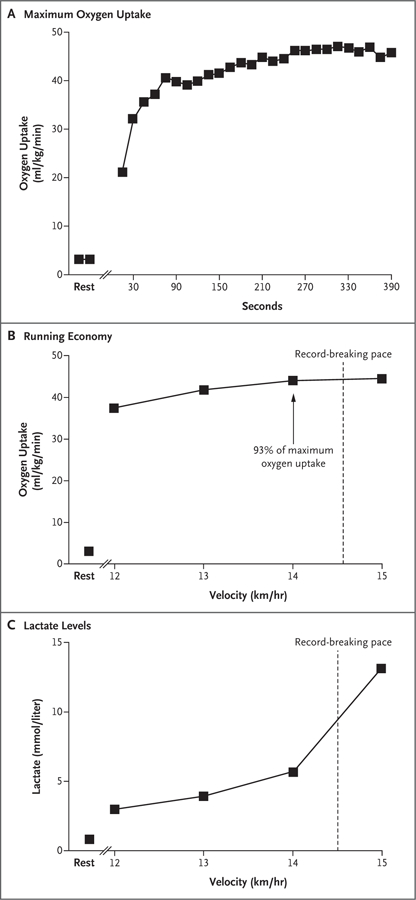TO THE EDITOR:
We determined the physiological profile of a 70-year-old male marathoner who ran the event in 2:54:23 (6:39 minutes per mile [4:09 minutes per kilometer]) on December 15, 2018, breaking the record time for men over the age of 70 years set in 2004.1 Endurance performance is determined by three primary physiological variables: maximum oxygen uptake, running economy (oxygen use for a given running velocity), and lactate threshold (exercise intensity at which lactate begins to accumulate).2 These measures are influenced by age, general physical health, and training.2–4
As part of the evaluation, the marathoner underwent both medical screening and performance testing. (Details are provided in the Supplementary Appendix, available with the full text of this letter at NEJM.org.) Performance testing consisted of running on a graded treadmill with gas-exchange measurements for determination of maximum oxygen uptake, testing of running economy (12 to 16 km per hour at 0% grade, 5 minutes each), and lactate threshold (by means of venous blood sampling).
The marathoner’s height was 176.5 cm, his weight was 64.2 kg, and he had exceptional cardiometabolic health (body fat, 19.1%; blood pressure, 122/75 mm Hg; blood glucose, 86 mg per deciliter [4.8 mmol per liter]; and total cholesterol, 173 mg per deciliter [4.5 mmol per liter]). His training consisted of running 40 to 50 miles per week.
Performance data are presented in Figure 1. His maximum oxygen uptake was 46.9 ml per kilogram of body weight per minute, a level that was exceptional for his age (the average for an age-matched male is approximately 26 ml per kilogram per minute) but much lower than expected for an athlete who can run a marathon in less than 3 hours.2 His running economy was similar to values reported in younger competitive runners.2 He reached the lactate threshold at approximately 14 km per hour (6:54 minutes per mile [4:16 minutes per kilometer]), which corresponds to a maximum oxygen uptake of approximately 93%. Notably, his record marathon pace of 6:39 minutes per mile is faster than that threshold, which is remarkable, because it is generally thought that marathon runners maintain approximately 75 to 85% of their maximum oxygen uptake.5
Figure 1. Results of Performance Testing in Marathon Runner.

Shown are the marathoner’s performance-testing results, including the maximum oxygen uptake (Panel A). During this evaluation, the maximum heart rate was 156 beats per minute (104% of the age-predicted maximum heart rate), the maximum ventilation was 112 liters per minute, and the rating of perceived exertion was 19/20. Also shown are oxygen uptake values obtained at different running velocities (running economy, Panel B) and lactate values at the same velocities (Panel C). The dashed line represents an interpolated value for a running speed of 14.5 km per hour (6:39 minutes per mile [4:09 minutes per kilometer]), the average pace of this runner during his record-breaking marathon performance.
We considered the possibility that this athlete’s measured running economy on the treadmill was worse than his overground running, which would lead to spurious conclusions. Several observations make this unlikely. First, during overground training, the marathoner reported heart rates in the lower 140s at marathon-race pace, similar to what we measured while he was running at a nearly marathon pace on the treadmill (14 km per hour, for a marathon pace of 3:00:28). Second, his running economy as measured on the treadmill was similar to that of elite younger runners.2,4 Third, even a 5% improvement in running economy during overground running would still indicate that he could probably sustain a marathon pace of at least 90% of his maximum oxygen uptake, a remarkably high value. In conclusion, these data suggest that this master athlete’s ability to maintain a remarkably high percentage of his maximum oxygen uptake played a role in enabling him to run a marathon in 2:54:23.
Supplementary Material
Acknowledgments
Supported by a grant (P20 GM113125) from the National Institutes of Health and a grant (AHA 18POST34060020) from the American Heart Association.
Footnotes
Disclosure forms provided by the authors are available with the full text of this letter at NEJM.org.
Contributor Information
Austin T. Robinson, University of Delaware, Newark, DE
Joseph C. Watso, University of Delaware, Newark, DE
Matthew C. Babcock, University of Delaware, Newark, DE
Michael J. Joyner, Mayo Clinic, Rochester, MN
William B. Farquhar, University of Delaware, Newark, DE
References
- 1.Lepers R, Cattagni T. Age-related decline in endurance running performance: an example of a multiple World records holder. Appl Physiol Nutr Metab 2018;43:98–100. [DOI] [PubMed] [Google Scholar]
- 2.Joyner MJ, Coyle EF. Endurance exercise performance: the physiology of champions. J Physiol 2008;586:35–44. [DOI] [PMC free article] [PubMed] [Google Scholar]
- 3.Joyner MJ. Modeling: optimal marathon performance on the basis of physiological factors. J Appl Physiol 1991;70:683–7. [DOI] [PubMed] [Google Scholar]
- 4.Barnes KR, Kilding AE. Running economy: measurement, norms, and determining factors. Sports Med Open 2015;1:8. [DOI] [PMC free article] [PubMed] [Google Scholar]
- 5.Bassett DR Jr, Howley ET. Limiting factors for maximum oxygen uptake and determinants of endurance performance. Med Sci Sports Exerc 2000;32:70–84. [DOI] [PubMed] [Google Scholar]
Associated Data
This section collects any data citations, data availability statements, or supplementary materials included in this article.


